Question bank
Chapter-1 Turning Forces and Centre of Gravity
Q-1
Define the following terms and state the units of each:
(i) Parallel forces
(ii) Moment of a force
(iii) A couple
(iv) Torque
(v) Moment of a couple
Q-2
Answer the following questions.
(a) What is meant by a moment of force? How is it measured?
(b) What are the two types of moments? Illustrate with diagrams.
(c) State the principle of moments.
(d) Explain the practical applications of the principle of moments.
(e) Is torque a vector or a scalar quantity? Explain.
(f) What is a couple and state its units?
(g) Give two examples of a couple.
(h) What is the moment of a couple?
(i) How is the moment of a couple measured?
(j) What is meant by the centre of gravity of a body?
(k) Can the centre of gravity be situated outside the body? Explain with two examples.
Q-3
Draw diagrams indicating the centre of gravity of:
(a) A triangle
(b) A rectangle
(c) A circle
(d) A cylinder
(e) A cone
(f) A ring
Q-4
Give reasons:
Hint: Common point to be stated for each of the above:
To turn a body about an axis depends upon the perpendicular distance between the axis of rotation and line of action. As a result, larger the perpendicular distance, less is the force required to produce same turning effect. Thus it is easy to turn a body by applying a smaller force.
(i) It is easier to open a door by applying the force at the free end of it.
(ii) The stone of a hand flour grinder is pivoted with a handle near its rim.
(iii) A spanner or wrench has a long handle.
(iv) It is easier to turn the steering wheel of a large diameter than that of a small diameter.
(v) To turn the bicycle wheel, the foot pedal is attached with a wheel of larger size.
Q-5
The diagram below shows a lever of uniform mass supported at the centre point. Four coins of equal mass are placed at the 4 cm mark on the left side.

(i) Can you balance the lever with 8 coins of equal mass? If yes where would you place them? If no, give your reason .
(ii) With the four coins still on the left two coins are placed on the right at mark 4. Where on the right should you pile an additional 4 coins to balance the rod?
Q-6
Cardboard pieces are cut into the shapes as shown below. On each diagram, draw two lines to indicate the accurate position of the centre of the gravity.

Q-7
A rectangular sheet of cardboard is suspended from the point O and held as shown in the diagram. When it is released from this position it moves and then comes to rest.
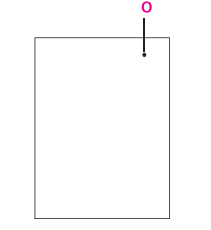
(a) Explain why it moves and show on the diagram the rest position of the sheet of cardboard .
Q-8
Explain?
(a) Explain why the motion of satellites revolving in almost circular paths is an example of accelerated motion.
(b) A body goes round the Sun with constant speed in a circular orbit. Is the motion uniform or accelerated?
(c) State two conditions for a body, acted upon by several forces to be in equilibrium.
(d) Is the following statement correct? If not write the correct statement.
"The Earth moves around the Sun with uniform velocity".
Q-9
Name the physical quantity of the body that:
(i) Remains constant during circular motion.
(ii) Changes continuously during circular motion.
Q-10
State the condition when a body is in:
(i) Static equilibrium
(ii) Dynamic equilibrium
Q-11
Give two differences between :
(i) Uniform linear motion and Uniform circular motion
(ii) Centripetal force and Centrifugal force
Multiple Choice Questions
Q-1 Torque depends upon:
(i)
None of these
(ii)
Magnitude of force
(iii)
Perpendicular distance of the line of action
(iv)
Both (a) and (b)
Q-2 Centrifugal force is:
(i)
Real force
(ii)
Fictitious force
(iii)
A force of reaction force of centrifugal force
(iv)
Directed towards centre of circular path
Q-3 The Moment of Force of 5 N about a point P is 2 N m. The distance of point of application of the force at point P will be:
(i)
0.4 m
(ii)
4 m
(iii)
40 m
(iv)
0.2 m
Q-4 The moment of force is negative for:
(i)
Clockwise moments
(ii)
Anticlockwise moments
(iii)
Both (a) and (b)
(iv)
None of these
Q-5 A force acting on a stationary rigid body which is free to move in a straight line is called:
(i)
Linear motion
(ii)
Circular motion
(iii)
Rotational motion
(iv)
None of the above
Q-6 The centre of gravity of a hollow cone of height "h" is at a distance x from its vertex. Value of x is:
(i)
h/3
(ii)
2h/3
(iii)
h/4
(iv)
3h/4
Q-7 Which of the following quantity remains constant in uniform motion?
(i)
Velocity
(ii)
Speed
(iii)
Acceleration
(iv)
Both velocity and speed
Q-8 Relation between SI and CGS unit of moment of force is:
(i)
1Nm=10^5 dyne
(ii)
1Nm=10^7 dynecm
(iii)
1Nm=10^6 dynecm
(iv)
None of these
Q-9 A physical balance works on the principle of:
(i)
Conservation of energy
(ii)
Principle of moments
(iii)
Principle of machines
(iv)
Moment of force
Q-10 The point about which the algebraic sum of Moments of Weights of all particles of the body is zero:
(i)
Centre of mass
(ii)
Mid-point of body
(iii)
None of these
(iv)
Centre of gravity
Q-11 Force required for circular motion of a planet around the Sun in circular path is:
(i)
Repulsion force
(ii)
Centrifugal force
(iii)
Gravitational force
(iv)
Electrostatic force
Q-12 Which statement is true for circular motion?
(i)
Velocity is constant, speed is variable
(ii)
Both velocity and speed remain constant
(iii)
Uniform acceleration
(iv)
Non-uniform acceleration
Q-13 It is necessary that the Centre of Gravity always be within the material of the body:
(i)
False sentence
(ii)
None of these
(iii)
No idea
(iv)
True sentence
Q-14 The iron door of a building is 2 m broad. It can be opened by applying a force of 80 N normally at the middle of the door. Select the step/steps required to calculate the torque needed to open the door.
1. Torque = F + S = 80 + 2 Nm 2. Torque = F x S = 80 x 2 N m 3. Torque = F + S = 80 + 1 Nm 4. Torque = F x S = 80 x 1 N m 5. Force = 80 x S = 80 x 2 N 6. Force = 80 + S = 80 + 1 N
(i)
1 and 3
(ii)
2, 1 and 4
(iii)
4 and 6
(iv)
5 and 6
(v)
4
Q-15 To calculate the least force and its point of application to open the door in (xiv) is:
(i)
40 N at the end of the door
(ii)
40 N at its midpoint
(iii)
80 N at its end (end of door)
(iv)
160 N at its end
(v)
80 N at the 1.5 m distance
Chapter-2 Work, Energy and Power
Q-1
Define the following:
(i) Work
(ii) The SI unit of work
(iii) CGS unit of work
(iv) Energy
(v) Power
(vi) Potential Energy
(vii) Kinetic Energy
(viii) Momentum
(ix) Watt hour
Q-2
Answer the following Question.
(a) Is it possible that a force is acting on a body but still the work done is zero? Explain giving one example.
(b) What is the work done against gravity when a body is moved horizontally along a frictionless surface?
(c) What should be the angle between the direction of force and the direction of motion of a body so that the work done is zero?
(d) What should be the angle between the force and the displacement for maximum and minimum work?
(e) Derives the relation between KE, momentum and mass.
(f) State the SI units of:
(i) Energy, (ii) Power
(g) State the law of conservation of energy.
(h) Distinguish between PE and KE and give two examples of each
(i) Express giga joule (GJ) and giga-watt in joule and watt and in their SI units respectively.
(j) Give examples to show that work and energy are interrelated physical quantities.
(k) Under what condition is a body said to possess energy?
(l) How will you justify that the total mechanical energy is conserved?
(m) Give examples of bodies possessing both PE and KE at the same time.
(n) In a tug-of-war, team A is slowly giving way to team B. What work is being done, and by whom?
(o) A man rowing a boat upstream is at rest with respect to the shore. Is he doing any work? If he stops rowing and moves down with the stream, is any work being done on him?
(p) Does work done in raising a box onto a platform depend on how fast it is raised?
(q) What is the work done in holding a 5 kg suitcase while waiting for a train for 10 minutes? Give reason for your answer.
(r) From the ground floor, a man comes up to the fourth floor of a building, using the staircase. Another person comes up to the same floor using an elevator. Neglecting friction, compare the work done in the two cases.
(s) When a porter carrying a suitcase in his hand or on his head is walking horizontally, "the work done against gravity is zero". Is the statement true? If 'Yes' then explain why the statement is true.
(t) A light mass and a heavy mass have equal momentum. Which will have more KE? Explain.
(u) In what case is the PE equal to zero?
(v) What is the measure of the potential energy of a body at a certain height above the surface of the Earth?
(w) In what case is the KE of a body assumed to be zero?
(x) What type of energy does a flying aeroplane possess with respect to the Earth?
(y) The masses of two falling bodies are the same. Find whether the values of the potential energy of the bodies are the same at the same height. Are the values of the KE also the same at that height?
Q-3
Explain giving scientific reasons:
(i) A cycle moving with speed on a level road moves up to a certain distance on an uphill road even without pedaling.
(ii) There is a speed limit for loaded heavy vehicles and trains moving over a long bridge.
(iii) Kinetic energy is always positive.
(iv) A bullet makes a clear hole in the wind shield of a car, but a stone moving with a far less speed breaks it into pieces.
Q-4
Classify the following examples into KE and PE:
(i) A wound spring
(ii) Flowing water
(iii) A stretched bow string
(iv) Water stored on a mountain top
(v) A bullet fired from a gun
(vi) An electron spinning around the nucleus
Q-5
State the energy changes that take place in the following:
(i) Water in the freezer of a refrigerator turns to ice.
(ii) A photographic film is exposed.
(iii) An electric bell rings.
(iv) The food consumed is digested.
(v) Water from dams rotate the turbines of a dynamo.
(vi) A nuclear reactor
Q-6
Match the column :

Q-7
Fill in the blanks :
(a) __________ is required to move things.
(b) Work done is Maximum and positive when angle between force and displacement is __________ degree.
(c) In circular motion ________and_________ are at an angle __________ degree as a result work done by the given force is __________
(d) Energy possesses by stretched bow and arrow is an ___________.
(e) Unit horse power related to its SI unit watt is equal to _________.
Q-8
Assertion: A 40 kg girl is running along a circular path of radius 1 metre with a uniform speed. The work done by the girl is zero.
Reason: Force and displacement are parallel to each other as a result angle between force and displacement is zero degree.
(a) Both assertion and reason are wrong. (b) Assertion is correct but reason is wrong. (c) Assertion is wrong but reason is correct. (d) Assertion and reason both are correct.
Q-9
Assertion: No transformation of energy takes place in photosynthesis.
Reason: In photosynthesis light energy transformation is from light energy to chemical energy.
(a) Both assertion and reason are wrong. (b) Assertion is correct but reason is wrong. (c) Assertion is wrong but reason is correct. (d) Assertion and reason both are correct.
Multiple Choice Questions
Q-1 1 kWh = ______ J
(i)
3.6 X 10^2 J
(ii)
3600 J
(iii)
3.6 X 10^6 J
(iv)
3.6 X 10^5 J
Q-2 1 horsepower is:
(i)
786 W
(ii)
764W
(iii)
476W
(iv)
746W
Q-3 An object which has the capacity to do work is said to possess:
(i)
Inertia
(ii)
Force
(iii)
Pressure
(iv)
Energy
Q-4 An object having mass m, moves with velocity v and possesses KE K. If its velocity is doubled, its KE will be:
(i)
K/4
(ii)
K/2
(iii)
2K
(iv)
4K
Q-5 In which of the following activities is the PE converted to KE?
(i)
The explosion of a fire cracker
(ii)
The switch on torch
(iii)
The swinging of a pendulum
(iv)
The body resting at a height
Q-6 Scientific concept of work suggests that work is done if:
(i)
The energy must be consumed
(ii)
Force acts on an object
(iii)
The object must be displaced
(iv)
Both (a) and (b)
Q-7 If a force F is applied on a body and it moves with a velocity v the power will be:
(i)
F/v
(ii)
Fv^2
(iii)
F/v^2
(iv)
Fv
Q-8 Unit of work done in SI system is:
(i)
joule
(ii)
newton metre
(iii)
calorie
(iv)
Both (a) and (b)
Q-9 When a coil spring is compressed, work is done on it. The elastic PE:
(i)
Decreases
(ii)
Disappears
(iii)
No change
(iv)
Increases
Q-10 The energy of 4900J was expended in lifting a 50 kg mass to a height of _______.
(i)
98 m
(ii)
960 m
(iii)
245000 m
(iv)
10 m
Q-11 Two spheres of same size, one of mass 5 kg and the other of mass 10 kg, are dropped simultaneously from the same tower. When they reach the ground, they both have:
(i)
Same momentum
(ii)
Same KE
(iii)
Same PE
(iv)
Same acceleration
Q-12 Energy required to accelerate a car from 10 ms-1 to 20 ms-1 compared with that required to accelerate it from 0 to 10 ms- 1 is:
(i)
Two times
(ii)
Three times
(iii)
Four times
(iv)
Same
Q-13 When a light body and a heavy body have equal momentum then:
(i)
Both have the same KE
(ii)
The heavy body will have more KE than the lighter body
(iii)
None of these
(iv)
The lighter body will have more KE than the heavy body
Q-14 Energy changes taking place in a loudspeaker is:
(i)
Mechanical energy to electric energy
(ii)
Sound energy to mechanical energy
(iii)
Electrical energy to sound energy
(iv)
Sound energy to electrical energy
Q-15 In thermocouple energy, the change that takes place is:
(i)
Electric energy to heat energy
(ii)
Heat energy to mechanical energy
(iii)
Heat energy to electric energy
(iv)
Mechanical energy to heat energy
Chapter-3 Simple Machines
Q-1
Define the following terms:
(i) Simple machine
(ii) Mechanical Advantage
(iii) Velocity Ratio
(iv) Efficiency
(v) Lever
(vi) Pulley
Q-2
Answer the following Questions.
(i) Derive the relation between MA, efficiency and VR for a machine.
(ii) How many types of levers are recognised? State the characteristics of each. Also draw diagrams and find the MA of each type.
(iii) Draw a labelled diagram of any one form of lever machine suitable for compressing a piece of cork with comparatively small effort.
(iv) Explain why wire cutters give a gain in force.
(v) Why is useful work not equal to total work when mechanisms are employed to lift loads and overcome resistances?
(vi) A single fixed pulley does not provide any MA, still it is used very often. Explain.
(vii) Show how a single pulley can be used to reduce the force required to overcome a given load. If two pulleys are used, one fixed and the other movable, then show how MA, VR and efficiency of the system change as compared to the first part.
(viii) Can a fixed and movable pulley be regarded as levers? Draw a schematic diagram to justify your answer.
(ix) In what direction must force be applied when a single pulley is to be used with MA greater than one? Explain.
(x) A pulley system has velocity ratio 3 and an efficiency of 90%. Draw a labelled diagram of this pulley system and calculate the MA of the system.
(xi) Draw a labelled diagram of an ideal pulley system with two pulleys each in the upper fixed block and in the lower movable block. Deduce the MA of the system.
(xii) Draw a diagram showing a system of 5 pulleys, the upper three being fixed and the lower two movable. Show from where the string is attached and where it terminates. Calculate the MA of the system for an ideal one.
Q-3
Give one example each of a lever:
(i) Used in everyday life
(ii) Used in engineering
(iii) Used in body parts
Q-4
Explain the following terms:
(i) Useful work
(ii) Total work
Q-5
Classify the following levers. Draw schematic diagrams showing the fulcrum and points of application of the load and effort.
(i) A nut cracker
(ii) An oar used to row a boat
(iii) Human forearm
(iv) Opening the door
(v) Coal tongs
(vi) A physical balance
(vii) A crowbar
(viii) A wheel barrow
(ix) A fishing rod
Q-6
Give reasons for the following:
(a) In an actual machine, the VR is always more than MA.
(b) The efficiency of a practical machine is less than 100%.
(c) In the case of block and tackle system, MA increases with the number of pulleys.
Q-7
Name a machine:
(a) Used to multiply force
(b) Used to multiply speed.
(c) Used to change the direction of force applied.
(d) Which has mechanical advantage greater than one.
Q-8
Which class of lever does the human jaw represent in each of the following cases:
(i) Eating an apple
(ii) Cracking a nut
Q-9
Figure A shows a crate being raised by a lever.
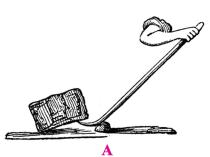
(a) Label on the figure the effort, the load and the fulcrum . Show the direction by means of arrows in which the load and effort moves. Mark the exact position of the fulcrum .
(b) Which order of lever does the figure represent?
Q-10
Figure B shows a nail being removed from a block of wood. In the diagram:
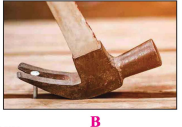
(a) Mark the fulcrum F.
(b) Draw the arrow L, to show the direction of the resistance (load).
(c) Draw an arrow E, to show the direction of the effort.
Q-11
What type of lever does the diagram show? Give two examples of this type of lever.

Q-12
Select a suitable simple machine used in the following cases. Justify your choice.
(a) Lifting heavy loads
(b) Applying power to a convenient point.
(c) Applying power in a convenient direction.
(d) Increasing speed.
Q-13
Show by means of a suitable diagrams how a single pulley can be used:
(a) To change the direction of the effort downward.
(b) To reduce the force required to overcome a heavy load .
Q-14
The diagram alongside shows a pulley arrangement.

(a) What is the purpose of the fixed pulley?
(b) Deduce the MA of the system.
(c) Calculate the VR of the system.
(d) Why is the efficiency not 100%?
Multiple Choice Questions
Q-1 For an ideal machine:
(i)
Output energy = input energy
(ii)
MA= VR
(iii)
Output energy > input energy
(iv)
Both (b) and (c)
Q-2 A single fixed pulley is used as:
(i)
Speed multiplier
(ii)
Force multiplier
(iii)
None of these
(iv)
To apply effort in a convenient direction
Q-3 An example of a lever is:
(i)
Pulley
(ii)
Bicycle
(iii)
Scissors
(iv)
Screw
Q-4 Which of the following are properties of an ideal machine?
(i)
MA and VR are equal
(ii)
All of the above
(iii)
Efficiency of the machine is 100%
(iv)
Friction in the machine is zero
Q-5 A force multiplier is a simple machine that multiplies:
(i)
None of these
(ii)
Load
(iii)
Effort
(iv)
Speed
Q-6 A ferris wheel is an example of:
(i)
Fixed Pulley
(ii)
Movable pulley
(iii)
Inclined plane
(iv)
Wheel and axle
Q-7 When we use the machine as a force multiplier then,
(i)
load < effort
(ii)
None of these
(iii)
effort < load
(iv)
effort = load
Q-8 Correct relationship between MA, VR and η is:
(i)
η= VR x MA
(ii)
η = VR/MA
(iii)
MA = η x VR
(iv)
VR = η X MA
Q-9 The MA of a machine is 5. The effort necessary to lift a load of 100 N is:
(i)
100 N
(ii)
0.05 N
(iii)
20 N
(iv)
50 N
Q-10 With reference to the term MA, VR and ri of a machine, the term that will not change for a given design machine is:
(i)
MA
(ii)
VR
(iii)
η
(iv)
None of these
Q-11 A single fixed pulley and a movable pulley are both used separately to lift a load of 50 kg to the same height. The (comparison) ratio of efforts applied is:
(i)
2:2
(ii)
1 :2
(iii)
2:1
(iv)
1 : 1
Q-12 If a block and tackle system with convenient direction has 3 movable pulleys in the lower block, then its VR:
(i)
Is either 6 or 7
(ii)
Should be 6
(iii)
Should be 7
(iv)
Is 3
Q-13 The total number of pulleys in a block and tackle system are 4 and the effort is applied upward. Then MA and VR for an ideal system are:
(i)
5;5
(ii)
5;4
(iii)
4 ; 4
(iv)
4;5
Q-14 If the load in (xiii) moves up a distance 'x', then by what distance will be an effort move up?
(i)
4x
(ii)
5x
(iii)
x/5
(iv)
x/4
Q-15 MA related to the VR for a practical machine is:
(i)
MA< VR
(ii)
None of these
(iii)
MA>VR
(iv)
MA= VR
Chapter-4 Refractions of Light
Q-1
Answer the following Questions.
(i) State the laws of refraction . Give an illustrative diagram.
(ii) What do you understand by the term refraction of light? How does the light deviate when it travels from: a. Rarer to denser medium b. Denser to rarer medium?
(iii) Explain what is meant by an absolute refractive index.
(iv) Describe an experiment to verify the laws of refraction .
(v) What is meant by lateral displacement? Illustrate with the help of a neatly labelled diagram.
(vi) On which factors does lateral displacement depend?
(vii) Explain the apparent depth of water tank when seen in water. Draw a diagram to illustrate your answer.
(viii) State the relationship between apparent depth, real depth and the refractive index of medium.
(ix) State the principle of reversibility of light
(x) Use a diagram to explain the formation of multiple images of an object seen in a glass block with a silvered surface. Of all the images, which image is the brightest? Why?
(xi) What is meant by the term mirage? Explain the formation of a mirage in the desert with the help of a neatly labelled diagram.
(xii) Define the critical angle of a substance. Draw diagrams to illustrate the course of the refracted ray when the angle of incidence is:
a. less than, b. equal to, c. greater than the critical angle
(xiii) Explain the term "total internal reflection" with the help of a neat diagram and state the conditions necessary for total internal reflection to occur.
(xiv) State the relationship between sine of critical angle and refractive index of a medium
(xv) What is a prism? Draw the path of a ray of monochromatic light through an equilateral glass prism showing clearly:
a. angle of incidence, b. angle of refraction, c. angle of deviation, d. angle of emergence
(xvi) State the factors which determine the angle of deviation.
(xvii) What is a totally reflecting prism?
(xviii) By means of diagrams, show that certain angled prisms can be used to reflect light through (i) 90° (ii) 180°. Explain fully how each prism acts and where they are used.
(xix) Draw the diagram of a right angled isosceles triangle prism which is used to make an inverted image erect.
(xx) Explain the term "angle of minimum deviation". State the condition to be satisfied.
Q-2
The diagram alongside shows the refraction of a ray through a prism. Copy the diagram and ignoring dispersion at the faces AB and AC mark the following angles:
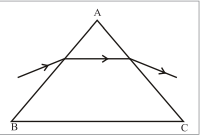
(i) The angle of incidence
(ii) The angle of refraction at face AB.
(iii) The angle of emergence
(iv) The angle of deviation
(v) The angle of prism
Q-3
A ray of light is incident on the face AB of a rectangular glass block as shown in the diagram.
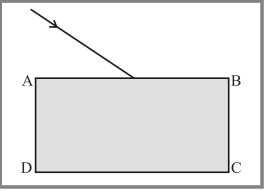
(i) Copy the diagram and draw the path of the ray through the block.
(ii) In the diagram label the angle of incidence 'i' and the angle of refraction 'r' at the interface AB.
(iii) In the diagram label the angle of incidence 'r1 ' and the angle of emergence 'e' at the surface DC.
(iv) Write the relation between the refractive index of glass and the angles 'i' and 'r'.
(v) Write the two pairs of angle which are same.
Q-4
Shorts Answer Type Question
(i) What do you understand by the term:
a. Refractive index of water = 1.33 b. Refractive index of glass = 1.5?
(ii) Write down the expression of refractive index in terms of velocities, when it travels from air to medium.
(iii) When will a ray of light pass from air into glass with no change in its path?
(iv) On what factors does the refractive index of a medium depend?
(v) What should be the ratio of the speed of light through a liquid to the speed through glass so that there is no refraction of light at the boundaries of the glass block when the system is illuminated by light of one colour?
(vi) What should be the ratio of the speed of light through a liquid to the speed through glass so that there is no refraction of light at the boundaries of the glass block when the system is illuminated by light of one colour?
(vii) State the equation for the relation between the frequency and wavelength of light in vacuum.
(viii) What is the relation between the angle of incidence i in the liquid and the angle of refraction r in the glass?
(ix) Express the refractive index (µ) of a medium: a. In terms of the velocity of light. b. In terms of the angle of incidence i in air and the angle of refraction r in a denser medium.
(x) If a ray of light passes from medium I to medium II without any change of direction, what can be said about the refractive indices of these media? (angle i is not 0)
Q-5
Explain why:
(i) A stick dipped in water appears bent and short at the surface of water when viewed obliquely from above. Draw a neat diagram to explain.
(ii) A coin placed at the bottom of a vessel full of water appears to be lifted or raised. Draw a neat diagram to explain.
(iii) The image of a person sitting opposite the camp fire appears to shimmer.
(iv) During spear fishing, the fisherman aims at the tail of the fish.
(v) Stars twinkle but planets do not twinkle.
(vi) The Sun is visible a little before the actual sunrise and a little after the actual sunset.
(vii) The Sun appears larger during sunset and sunrise.
(viii) A tank filled with water appears shallow. Draw a neat diagram to explain.
(ix) To a fish in water looking at a plant outside the water, the plant appears taller than its actual height. Draw a neat diagram to explain.
(x) When a test-tube containing water is kept inclined in a beaker filled with water, the part of the tube containing air and immersed in water appears to shine.
(xi) A sooty ball suspended in water appears silvery.
(xii) A diamond glitters in a brightly lit room.
(xiii) A crack in a window-pane appears silvery.
(xiv) Cut glass articles sparkle.
(xv) A bubble of air rising up from the bottom of a water tank appear silvery when viewed from top.
Q-6
A monochromatic point source of light O is seen through a rectangular glass block ABCD. Paths of two rays, in and outside the block, are shown in the figure alongside.
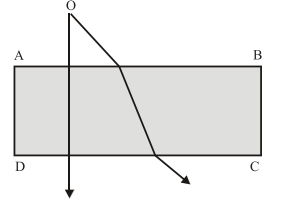
(i) Does the source O appear to be nearer or farther with respect to the surface AB?
(ii) How does the shift depend on the thickness (AD or BC) of the block?
(iii) Justify your answer in (ii) with the help of an appropriate ray diagram
(iv) For the same rectangular block, which colour from the visible spectra will produce the maximum shift?
Q-7
The diagram alongside shows the path of a ray of light, through a rectangular glass block placed in a liquid of uniform density.
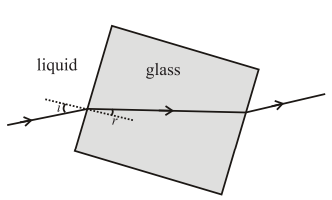
(i) a. Does the light speed up or slow down in glass?
b. Give reasons for your answer.
(ii) What is the angular deviation of the emergent ray from the glass block with respect to the incident ray?
(iii) Show with the help of a ray diagram, the path of the ray when incident normally on the first surface of the glass block, through the block and the liquid.
Multiple Choice Questions
Q-1 The RI of a material does not depend upon the _____
(i)
Nature of the material of the medium
(ii)
Optical density of the medium
(iii)
Wavelength of light
(iv)
Frequency of light
Q-2 When a ray is travelling from a rarer medium to a denser medium:
(i)
The speed of light increases
(ii)
The wavelength of light increases
(iii)
The ray will move away from the normal
(iv)
The ray will move towards the normal
Q-3 Arrange the following substances in their increasing order of velocity of light in the medium whose refractive indices are given as, glycerine = 1 .48, dense flint = 1.62, water = 1.33 and diamond = 2.1:
(i)
Dense flint, water, glycerine and diamond
(ii)
Diamond, dense flint, glycerine and water
(iii)
Diamond, water, glycerine and dense flint
(iv)
Water, glycerine, dense flint and diamond
Q-4 Which of the following medium is optically most dense?
(i)
Water
(ii)
Diamond
(iii)
Glass
(iv)
Air
Q-5 When a ray of light enters the medium B (µ = 1. 7) from a medium A (µ = 1.5), the speed of light:
(i)
Increases
(ii)
Decreases
(iii)
Remains the same
(iv)
None of these
Q-6 When a ray of light is refracted by a parallel glass slab, then the false statement is:
(i)
Both (a) and (b)
(ii)
Emergent ray is parallel to the incident ray
(iii)
Angle of incidence is equal to the emergence
(iv)
The angle of deviation is 90°
Q-7 In the position of minimum deviation, which of these is not correct for a glass prism?
(i)
δm = 2i - A
(ii)
Angle i = Angle e
(iii)
Angle i= δ
(iv)
Refracted ray is parallel to its base
Q-8 The ray PQ is incident at the critical angle of incidence. The correct path of the ray after the point Q is:

(i)
QB
(ii)
QC
(iii)
QA
(iv)
OD
Q-9 When the angle of incidence in the denser medium is equal to its critical angle, then the angle between the refracted ray and the surface of denser medium is:
(i)
180°
(ii)
45°
(iii)
0 °
(iv)
90°
Q-10 A microscope is focused on an ink mark on the top of a table. If a glass slab 3 cm thick is placed on it, how should the microscope be moved to focus on the spot again?
(i)
2 cm downwards
(ii)
2 cm upwards
(iii)
1 cm upwards
(iv)
1 cm downwards
Q-11 When light undergoes refraction, its frequency:
(i)
Increases
(ii)
Remains the same
(iii)
Decreases
(iv)
Increases exponentially
Q-12 A light ray enters from medium A to medium B as shown in the figure. The refractive index of medium B relative to medium A will be:
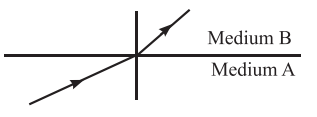
(i)
Less than unity
(ii)
Equal to unity
(iii)
Zero
(iv)
Greater than unity
Chapter-5 Refractions through Lenses
Q-1
Answer the Following Questions.
(i) What is a lens? Describe the different types of lenses.
(ii) Define the first and second focus of:
(i) A convex lens (ii) A concave lens. Give a diagram in each case.
(iii) Define the following terms: (Give a diagram to explain each term for both the lenses).
(i) The optical centre (ii) The principal axis of lens (iii) Principal focal plane (iv) Principal focus or foci (v) Focal length of a lens
(iv) What is an image? Distinguish between a real image and a virtual image.
(v) Distinguish between a convex lens and a concave lens.
(vi) Write two uses of each lens:
(a) Convex lens (b) Concave lens.
(vii) Define Power of a lens.
(viii) In which physical quantity is the power of a lens measured?
(ix) How is the power of a lens related to its focal length?
(x) Which type of lens has:
(a) A positive power? (b) A negative power?
(xi) What is the SI unit of power of a lens?
(xii) Describe fully how the focal length of a convex lens can be measured: (i) Empirically (ii) By using a plane mirror
(xiii) What is meant by the term 'magnification' produced by a lens? Write its expression in terms of object distance and image distance.
(xiv) Is the focal power of a thin lens more or less than that of a thick lens? Explain.
(xv) Draw a ray diagram showing a convex lens used as a simple magnifying glass. State the nature of image.
(xvi) Define, with the aid of a ray diagram, the terms principal focus and focal length for a diverging lens.
(xvii) What type of lens is used as a magnifying glass? Should the lens be thick or thin? Explain your answer
Q-2
Explain briefly:
(i) A lens is a combination of prisms.
(ii) A concave lens is a diverging lens.
(iii) A convex lens is a converging lens.
(iv) When a ray is incident at the optical centre, it suffers no refraction.
(v) Focal length of a convex lens is positive and that of a concave lens is negative.
Q-3
Draw a ray diagram to show the principle used in the following cases:
(i) A lens is a combination of prisms
(ii) Camera lens or a burning glass
(iii) Case of camera when the object is not very far
(iv) Slide projectors or a film projector
(v) As a reading glass or in simple microscope
(vi) In Galilean telescope
Q-4
Where would you place an object in front of a convex lens in order to produce:
(i) A real magnified image
(ii) An Image of the same size as the object
(iii) A real diminished image
(iv) An erect magnified image
Q-5
Answer these Questions.
(i) Explain with the aid of a diagram how a concave lens forms an image
(ii) Show through a diagram the refraction of two parallel incident rays by a concave lens by treating it as a combination of a glass block and two triangular glass prisms.
(iii) Draw the course of rays through a convex lens when it acts as a reading glass.
(iv) Name the type of lens that always gives a virtual and erect image. Support your answer with a ray diagram.
(v) Name the type of lens that is used to give an erect, virtual and magnified image. Give your answer with a ray diagram.
(vi) Which of the two has a greater power: a lens of short focal length or a lens of large focal length?
(vii) To focus near object by an eyelens, will the lens be thicker or thinner? Explain.
(viii) By means of a diagram, find the position and nature of the image formed by:
(i) A convex lens (ii) A concave lens
when a small object is placed on the axis of the lens, at a distance of twice its focal length.
(ix) If you were provided with two convex lenses of focal length 5 cm and 20 cm respectively, which one would you choose to provide the greater magnification when used as a simple magnifying glass? Give reason.
(x) Why is it possible to focus clearly on objects underwater when your eyes are under water if you wear goggles with plane glass in them, but not with the naked eye?
(xi) How would you use a converging lens of focal length about 5 cm to project a highly magnified image of an illuminated slide on the wall of the laboratory? Give a ray diagram of the arrangement.
Q-6
A beam of parallel rays of light falls on:
(i) A converging lens
(ii) A diverging lens. Give diagrams showing the emerging rays in each case
Multiple Choice Questions
Q-1 SI unit of power of a lens is:
(i)
millimetre
(ii)
diopter
(iii)
metre
(iv)
micrometre
Q-2 This lens is used as a reading lens:
(i)
Bi concave lens
(ii)
Concave lens
(iii)
Convex lens
(iv)
Convexo concave lens
Q-3 The correct lens formula is:
(i)
1/u +1/v + 1/f
(ii)
1/v - 1/u = 1/f
(iii)
1/u -1/v = 1/f
(iv)
1/v = 1/u - 1/f
Q-4 If the power of a lens is -2D, its focal length is:
(i)
500 cm
(ii)
-50 cm
(iii)
100 cm
(iv)
-100 cm
Q-5 A convergent beam of light passes through a diverging lens of focal length 50 cm. Power of the lens is:
(i)
+0.02 D
(ii)
-2 D
(iii)
+2 D
(iv)
-0.02 D
Q-6 The ray of light passing through this part emerges un-deviated.
(i)
Between focus and centre of curvature
(ii)
Focus
(iii)
Centre of curvature
(iv)
Optical centre
Q-7 Parallel incident rays converge to a point due to convex lens. The point is called:
(i)
Second focal point
(ii)
Centre of curvature
(iii)
First focal point
(iv)
Focal length
Q-8 If the object distance is negative and image distance is positive, the type of the lens is:
(i)
Concave lens
(ii)
Plano-concave lens
(iii)
None of these
(iv)
Convex lens
Q-9 When a concave lens is immersed in water its power:
(i)
Increases
(ii)
No change
(iii)
Cannot be measured
(iv)
Decreases
Q-10 Convex lens is used in a photographic camera because convex lens forms :
(i)
Real and magnified images
(ii)
Virtual and magnified images
(iii)
Virtual and diminished images
(iv)
Real and diminished images
Q-11 Convex lens forms a virtual image when the object is placed:
(i)
Between lens and the principle focus
(ii)
At infinity
(iii)
At distance double the focal length
(iv)
Beyond double the focal length
Q-12 When an object is placed at any finite distance from a concave lens the image is formed:
(i)
Between F2 and optical centre
(ii)
Beyond 2F
(iii)
Between F1 and 2F1
(iv)
At F 2
Q-13 Half the aperture of a converging lens covered with a stop is used to form an image on a screen. Which of the following is true?
(i)
A complete image of the object is formed with more intensity
(ii)
Both (a) and (b)
(iii)
Half the image of the object is formed with less intensity
(iv)
Focal length does not change but the intensity of the image decreases
Q-14 The magnifying power of a concave lens is:
(i)
Always> 1
(ii)
Always< 1
(iii)
Always = 1
(iv)
Can have any value
Q-15 An object is placed vertically at a distance of 20 cm from a convex lens. If the height of the object is 5 cm and focal length is 10 cm, the image formed is at:
(i)
- 20 cm
(ii)
-10 cm
(iii)
20 cm
(iv)
10 cm
Chapter-6 Spectrum
Q-1
Answer the following Questions.
(i) Explain the cause of dispersion
(ii) Explain with the aid of a carefully drawn diagram, how a spectrum is formed by using a glass prism.
(iii) Name the instrument used to obtain a pure spectrum.
(iv) Give a concise account of two methods of recombining the spectral colours so as to form the white light. Illustrate each method by a diagram.
(v) How are infrared and ultraviolet radiations detected?
(vi) What are the sources of infrared and ultra violet radiations?
(vii) What are the ranges of infrared and ultraviolet radiations?
(viii) Write down the electromagnetic spectrum in order of decreasing wavelengths or increasing frequencies.
(ix) Arrange infrared rays, X-rays, gamma rays, ultraviolet rays in increasing order of wavelengths.
(x) Write the visible spectrum in the increasing order with respect to wavelengths.
(xi) Write the visible spectrum in the increasing order with respect to frequencies.
Q-2
How do infrared rays differ from gamma rays with respect to:
(i) Wavelength?
(ii) Penetrating power?
Q-3
In the formation of spectrum by a prism:
(i) Which colour is deviated least?
(ii) Which colour is deviated to the maximum extent?
(iii) After which colour lies the violet colour from the red end?
(iv) After which colour lies the green colour from the violet end?
Q-4
The wavelength of red light is 8000 A. and wavelength of violet light is 4000 A..
(i) Will they have the same speed in glass?
(ii) Will they have the same speed in vacuum?
Q-5
Account for the following:
(i) The sky looks blue.
(ii) Distant hills appear blue.
(iii) During sunrise and sunset, the sky appears red.
(iv) Sunlight appears yellow.
(v) A washer man uses a little indigo blue after washing the clothes.
(vi) Clouds appear white near the earth surface.
(vii) In the absence of atmosphere sky appears black.
Q-6
Following figure represents a part of the electromagnetic spectrum (not to scale) extending on either side of the region of visible light. Letters A, B, C, D, E, F represent different types of radiation in order of increasing frequency.

(i) Name the radiations A, B, C, D, E, F
(ii) How are, the radiations represented by the regions C and D detected? Give two uses and properties of each.
(iii) Name the visible radiations at X and Y. Which has greater wavelength?
(iv) Compare the velocity of all radiations .
Q-7
Name the waves which are used:
(i) In radar.
(ii) To detect the purity of eggs and ghee.
(iii) In night photography.
(iv) For detecting fracture in bones and teeth.
(v) Which strongly affect the photographic plate and turn silver chloride paper brown.
Q-8
Explain the terms:
Name the various colours of the spectrum in order of their deviation.
(i) Dispersion of light
(ii) Deviation of light
(iii) Spectrum of light
(iv) Pure spectrum
(v) Impure spectrum
Multiple Choice Questions
Q-1 The source of ultraviolet light is:
(i)
Electric bulb
(ii)
Red hot iron ball
(iii)
Sodium vapour lamp
(iv)
Carbon arc lamp
Q-2 Infrared lamps have an envelope of:
(i)
Quartz
(ii)
Glass
(iii)
Rock salt
(iv)
Diamond
Q-3 Violet deviates the most because:
(i)
It has shortest wavelength
(ii)
It has the longest wavelength
(iii)
It travels fastest in prism
(iv)
None of these
Q-4 When radiation P is focused on the bulb of a thermometer, temperature rises rapidly. The radiation P is:
(i)
Infrared radiation
(ii)
X-rays
(iii)
Ultraviolet radiation
(iv)
Visible light
Q-5 Maximum scattering of while light (from Sun) by of the air molecules in earth's atmosphere is for:
(i)
Red colour
(ii)
Yellow colour
(iii)
Green colour
(iv)
Blue colour
Q-6 When a white light falls on a prism, the ray at its first surface suffers:
(i)
No refraction
(ii)
Only dispersion
(iii)
Only deviation
(iv)
Both deviation and dispersion
Q-7 The wavelength range of visible light is:
(i)
4000 n m to 8000 n m
(ii)
400 n m to 800 n m
(iii)
4 nm to 8 nm
(iv)
40 n m to 80 n m
Q-8 These radiations synthesize vitamin D in the human body:
(i)
X-rays
(ii)
Gamma rays
(iii)
Microwaves
(iv)
Ultraviolet rays
Q-9 These radiations find use in burning glass:
(i)
Ultraviolet
(ii)
Infrared
(iii)
Gamma
(iv)
X-rays
Q-10 These radiations are used in sterilising purposes:
(i)
Infrared
(ii)
Visible light
(iii)
Ultraviolet rays
(iv)
X-rays
Q-11 Select the true statement for a beam of red light refracted by a prism at the angle of minimum deviation:
(i)
Angle of incidence is more than angle of emergence and refracted ray bends towards the base of the prism
(ii)
Angle of incidence and angle of refraction are equal and refracted ray is parallel to its base
(iii)
All are correct
(iv)
Angle of incidence is equal to the angle of emergence and refracted ray is parallel to the base of prism
Q-12 Select the true statement for dispersion of white light by a prism placed in air:
(i)
On both the surfaces of prism, only deviation takes place
(ii)
On both the surfaces of the prism, only dispersion takes place
(iii)
On both the surface of prism, reflection takes place
(iv)
On the first surface of the prism, dispersion and deviation takes place, and on the second surface only deviation takes place
Q-13 Two waves A and B have wavelengths 0.01 A and 9000 A respectively. Compare the speed of these waves when they travel in vacuum.
(i)
3 : 1
(ii)
1 : 2
(iii)
1 : 1
(iv)
1 : 3
Q-14 Wavelength of red light is 800 nm. Frequency of red light is:
(i)
3.75 x 10^14 Hz
(ii)
3.75 x 10-^14 Hz
(iii)
3/8 x 10^6 Hz
(iv)
8/3 X 10-^6 Hz
Q-15 Wavelength of red and blue light have values of 7.8 x 10-1 m and 4.8 x 10-1 m respectively. Which colour has the greatest speed in glass?
(i)
Blue
(ii)
Red
(iii)
Both have same
(iv)
Cannot judge
Chapter-7 Sound
Q-1
Answer the folowing Questions.
(i) State the factors on which the velocity of sound depends.
(ii) Explain one method to determine the velocity of sound.
(iii) What is the range of audio frequencies?
(iv) What is meant by an echo?
(v) Describe an echo method for measuring the velocity of sound.
(vi) What is the condition necessary for an echo to be heard distinctly?
(vii) Give two practical applications of the echo.
(viii) What type of waves are produced when a bell rings in air?
(ix) Give three examples of resonance.
(x) Explain with examples, the characteristics of loudness, pitch and quality.
(xi) Name a musical instrument that makes use of the vibration of stretched string.
(xii) State four differences between light waves and sound waves.
(xiii) If v stands for the velocity of a wave, 'f' is the frequency of the wave and A is the wave length, write down an equation relating v, f and A
(xiv) Name the part of the instrument that vibrates to produce sound in each of the following:
(i) A violin (ii) An organ pipe (iii) A drum
(xv) If the sound of the same pitch are produced by three instruments mentioned above, why do the qualities of sound differ?
(xvi) What is the approximate value of the speed of sound in water as compared to that in air? Illustrate your answer with a simple experiment.
(xvii) Write down the factors on which the frequency of a vibrating stretched string depends.
(xviii) What adjustments will you make for tuning a stringed instrument, such as a violin, for it to emit a desired pitch?
Q-2
Name the sound waves:
(i) Below the audio range
(ii) Above the audio range
Q-3
Give reasons:
(i) Bats have poor eyesight but are able to home in on their prey with great accuracy.
(ii) Dolphins can avoid fishing nets and can detect fish at night.
(iii) For the construction of huge auditoriums and halls, carpets and curtains are used.
(iv) Sonar scanners are used by doctors.
Q-4
Distinguish between the following:
(i) Free and forced vibrations
(ii) Forced vibrations and resonance
(iii) Musical note and noise
(iv) Damped vibrations and Natural vibrations
Q-5
Calculate the minimum distance required to hear an echo:
(i) In air
(ii) In water
Q-6
What is the audible range in:
(i) Humans
(ii) Bats?
Q-7
Answer the following Questions.
(i) In which case is the speed of sound is more: in humid air or dry air? Why?
(ii) What is meant by reverberation?
(iii) Explain the term acoustics and state its significance.
(iv) State the factors that determine the loudness of a sound wave. What is the relationship between loudness and amplitude?
(v) A violin and a piano sound the same note in turn . What enables us to identify each instrument by only listening to the note produced?
(vi) If the rate of vibration of a sounding body is doubled, what is the effect on the pitch of the sounding body?
(vii) A lampshade vibrates in response to a certain note. Explain this.
(viii) Define intensity of sound.
(ix) How the intensity of sound depends on the factors listed below:
frequency; amplitude of vibration; the presence of harmonics; distance between the observer and the source.
(x) A sound wave produces compressions and rarefactions as it passes through air. How would the distance between successive compressions change if the sound were of a higher pitch?
(xi) What determines the pitch of a sound? Why do the qualities of sound of the same pitch differ when emitted by different instruments?
(xii) A person while driving a scooter observed that for a particular engine speed the rear view mirror with its rod vibrated noticeably. The vibrations disappeared when the engine speed was either increased or decreased. Name and explain this phenomenon.
(xiii) The sound of an explosion on the surface of a lake is heard by a boatman 1 00 m away and by a diver 100 m below the point of explosion. Of the two persons mentioned (the boatman and the driver), who would hear the sound first? Explain your answer.
(xiv) When a man gets excited his voice becomes shrill, and his voice becomes grave when he catches cold . Why?
(xv) Why are soldiers advised to break steps when they march over a suspension bridge at the time of crossing any river?
Q-8
The figure alongside shows a tuning fork with one of its prongs fastened to one end of a spring whose other end is fastened to a rigid support. When the tuning fork is made to vibrate, how does the pattern of the coils of the spring change?
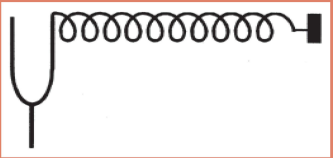
Q-9
State one factor that determines:
(i) Pitch of a note
(ii) The intensity of the sound heard
(iii) The quality of the note
Q-10
Explain why:
(i) If you place your ear close to an iron railing which is tapped some distance away, you hear the sound twice.
(ii) Sound can be heard by putting the ear near the railway line although the train is very far off and is not visible.
(iii) The intensity or loudness of the sound emitted by a plucked wire is increased when it is mounted on a board.
(iv) The velocity of sound in hydrogen is more than that in oxygen.
(v) Echo cannot be heard in a small room.
Q-11
Solve the Question
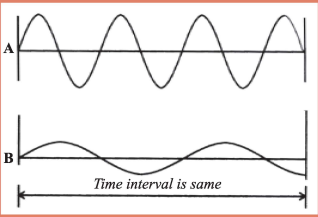
(i) Which of the diagrams A or B represents a sound of higher frequency? Give a reason for your answer.
(ii) Which of the diagrams represents a louder sound? Give a reason for your answer.
Q-12
The sketches A to D show sound waves, all formed in the same time interval. Which diagram represents:

(i) A note from a musical instrument which is not a pure note?
(ii) A loud pure note?
(iii) A bass (low frequency) note?
(iv) Noise?
Q-13
The diagram below shows three pendulums, A, B and C suspended from a horizontal string PO. The masses of the bobs of the pendulums are given in the diagram. What will you observe if the pendulum A is set into oscillations as shown? Name and explain the cause of your observations.
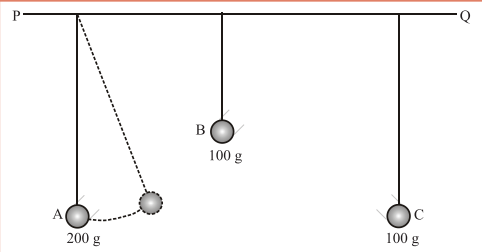
Q-14
Figure shows different modes of vibrations on a stretched string. (Fundamental frequency = 10 Hz)
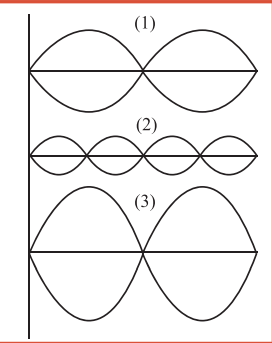
(i) Which case has the largest amplitude?
(ii) What is the frequency in case of 2 and 3 ?
(iii) What is the ratio of frequency between case 1 and 3 ?
Q-15
What change, if any would you expect in the characteristics of a musical sound when we increase:
(i) Its frequency?
(ii) Its amplitude?
Q-16
The rear view mirror of a motor bike starts vibrating violently at some particular speed of the motor bike.
(i) Why does this happen?
(ii) What is the name of the phenomenon taking place?
(iii) What could be done to stop the violent vibrations?
Q-17
A vibrating tuning fork is placed over the mouth of a burette filled with water. The tap is opened and the water level gradually falls.
(i) What do you observe?
(ii) Name the phenomenon.
(iii) When does this phenomenon happen?
(iv) If the water level in the burette falls further, will you notice the same observation again?
Multiple Choice Questions
Q-1 Resonance is a special case of:
(i)
Damped vibrations
(ii)
Free vibrations
(iii)
Natural vibrations
(iv)
Forced vibrations
Q-2 The persistence of hearing of the human ear is:
(i)
0.01 s
(ii)
0.1 s
(iii)
0.1 minute
(iv)
0.01 minute
Q-3 The speed of sound in water is 1400 ms-1. To hear an echo distinctly the reflecting surface in water should be at a minimum distance of _____ from the listener.
(i)
17m
(ii)
70m
(iii)
7m
(iv)
17.5m
Q-4 Ultrasonic waves are used in sound ranging and echo depth sounding because:
(i)
They travel long distance undeviated
(ii)
They travel faster than audible sound
(iii)
They cannot be confined to a narrow beam
(iv)
They can be heard
Q-5 Among the following properties of a wave, the one that is independent of the other is its:
(i)
Amplitude
(ii)
Velocity
(iii)
Frequency
(iv)
Wavelength
Q-6 A boy stands 85 m from a wall and produces 2 claps/second. The sound of clapping coincides with its echo. The echo is heard only once when the clapping is stopped. The speed of sound calculated is:
(i)
340 ms- 1
(ii)
350 ms- 1
(iii)
330 ms- 1
(iv)
300 ms- 1
Q-7 As the frequency of a sound wave decreases in a given medium, the wavelength of the wave:
(i)
Increases, but the speed of the wave remains same
(ii)
Increases, and the speed of wave also increases
(iii)
Decreases, but the speed of sound wave remains constant
(iv)
Both velocity and wavelength of the wave remain constant
Q-8 Which of the following device is used to transfer sound energy into electrical energy?
(i)
Loudspeaker
(ii)
Microphone
(iii)
SONAR
(iv)
Echo
Q-9 Technique used to locate the obstacle in the way of bats, dolphins etc. is:
(i)
Sound ranging
(ii)
Echo depth sounding
(iii)
Refraction of ultrasonic waves
(iv)
Reflection of infrasonic waves
Q-10 Identify the conditions required by humans to hear a clear and distinct echo in air.
(i)
The size of the reflecting surface should be smaller than the wavelength of sound
(ii)
Sound should not be reflected back within 0. 1 second
(iii)
The incident sound should have frequency more than 25,000 Hz
(iv)
The size of the reflecting surface should be larger than the wavelength of sound
Q-11 The diagram shows displacement ➔ time graph. The amplitude, time period and frequency is:
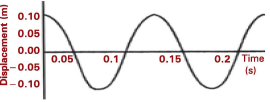
(i)
Amplitude = 0.1 m, Time period = 0.1 s, Frequency = 10 Hz
(ii)
Amplitude = 10 cm, Time period = 0. 15 s, Frequency = 15 Hz
(iii)
Amplitude = 20 cm, Time period = 0.05 s, Frequency = 100 Hz
(iv)
Amplitude = -10 cm, Time period = 1 O s, Frequency = 1 O Hz
Q-12 A wave passes from one medium to another medium, in doing so the property which does not change is:
(i)
Frequency
(ii)
Speed
(iii)
Wavelength
(iv)
Amplitude
Q-13 Which characteristics enables us to distinguish the sound of two musical instruments even when they are of the same pitch and loudness:
(i)
Loudness
(ii)
Resonance
(iii)
Quality
(iv)
None of the above
Q-14 Ratio of amplitude of two waves of same pitch is1 :3. Ratio of their intensities and frequencies is:
(i)
1: 1 and 1 :3
(ii)
1 :9 and 1: 1
(iii)
1 :9 and 1: 1
(iv)
1 :3 and 1 :9
Q-15 A wire of length 80 cm has a frequency of 256 Hz. The length of a similar wire under the same tension, having frequency of 1024 Hz will be:
(i)
20 cm
(ii)
3.2 m
(iii)
0.02 m
(iv)
320 cm
Chapter-8 Current Electricity
Q-1
Answer the following Questions.
(i) When is current said to flow in a conductor?
(ii) Define potential difference and state its SI unit.
(iii) What is an electric current?
(iv) State the SI unit of electric current.
(v) What is meant by 'conventional current' and 'electronic current' flow of electrons?
(vi) What is an electric cell?
(vii) What is meant by the electromotive force of a cell? In what unit is it measured?
(viii) What are series and parallel connections?
(ix) On what factors does the resistance of a conductor depend?
(x) State the SI unit of electric resistance.
(xi) State the factors that influence the resistivity of a given wire.
(xii) What is the SI unit of resistivity?
(xiii) Is the resistivity a vector or a scalar quantity?
(xiv) On which factors does resistivity not depend?
(xv) Which of the following has a lower resistivity?
a. A good conductor b. An insulator
(xvi) State Ohm's law. What are the limitations of the law?
(xvii) Define 'one ohm' of resistance. What are the larger and smaller units of resistance?
(xviii) Draw a diagram of an electric circuit set up to verify Ohm's law.
(xix) On the basis of this circuit, explain how you would proceed to verify Ohm's law with the help of graph.
(xx) Give the relation between:
(i) Resistance and specific resistance (ii) Resistance and conductance
(xxi) When does an electric lamp offer more resistance: when it is not lighted or when it is lighted? Explain your answer.
Q-2
Draw a simple electric circuit when the following components are given:
(i) Cell
(ii) Load
(iii) Key
(iv) Ammeter
(v) Voltmeter
(vi) Rheostat
Q-3
Define or explain the following terms:
(i) Electric resistance
(ii) Resistivity (specific resistance)
(iii) Electric rheostat
(iv) Electric circuit
(v) Open electric circuit
(vi) Closed electric circuit
Q-4
An electric bulb glows when connected to a chemical cell. Name the energy changes taking place:
(i) In the cell
(ii) In the bulb
Q-5
Answer these Questions

(i) What are ohmic and non ohmic conductors?
(ii) Sketch the graph of potential difference versus current for ohmic and non ohmic conductors.
(iii) What does the slope of the alongside graph indicate?
(iv) What are superconductors?
Q-6
Long answer type Questions.
(i) What is meant by equivalent resistance?
(ii) You are provided with four resistances (resistors) R1 , R2 , R3 and R4. Write the formula for the equivalent resistance R when these resistors are connected :
a. in series b. in parallel
(iii) What type of combination should be used for:
a. increasing of resistances? b. decreasing of resistances?
(iv) Explain the need for a combination of resistors in an electric circuit.
Q-7
Answer these Question.
(i) With the help of a circuit diagram, deduce the equivalent resistance of three resistors connected in series.
(ii) With the help of a circuit diagram, deduce the equivalent resistance of three resistors connected in parallel.
(iii) What is the internal resistance of a cell?
(iv) On what factors does the internal resistance of a cell depend?
(v) Explain the meaning of emf and terminal voltage of a cell .
(vi) The "terminal voltage" and "emf" of a cell are not the same. Explain with the help of a diagram.
(vii) Define the emf (e) of a cell and the potential difference (V) across a resistor R in terms of the work done in moving a positive unit charge.
(viii) State the relation between the two works done mentioned in (i), a resistor R and internal resistance of the cell r
(ix) Obtain an expression for the current I in the circuit.
(x) Why is the potential difference generally less than the emf of the cell?
(xi) When will the emf and potential difference of a cell be the same?
(xii) What happens to the resistance as the conductor is made thinner?
(xiii) What happens to the resistance if the length of the wire is constant and the radius is doubled?
(xiv) What happens to the resistance if the radius of the wire is constant and the length is doubled?
Q-8
The I --V graph for a series combination and for a parallel combination of two resistors is as shown in the figure alongside. Which of the two A or B, represents the parallel combination? Give reason for your answer.
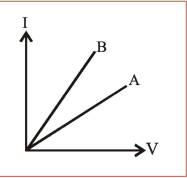
Q-9
Explain the statements:
(i) The potential at a point is 1 volt.
(ii) The potential difference between two points is 1 volt.
(iii) The potential difference between two points is 5.0 volt.
Q-10
Short type of Questions
(i) The voltage applied to a given rheostat is made four times its initial value. By what factor will the resistance of the rheostat change?
(ii) What are the conditions under which charges can move in a conductor?
(iii) How will you maintain a potential difference between the ends of a conductor?
(iv) By which name is joule/coulomb called?
(v) Name the device used for measuring:
a. Electric current b. Potential difference
Q-11
The diagram represents a circuit for the verification of Ohm's law.
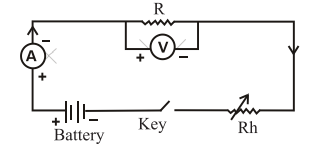
(i) State the function of each component used in the circuit diagram.
(ii) Account for the flow of an electric current through a metallic conductor.
(iii) Name the method used to verify Ohm's law.
(iv) What is the nature of the graph when plotted against V and I?
(v) Which physical quantity does the slope of the graph represent?
Q-12
A student made an electric circuit by connecting a battery, two meters and two lamps L1 and L2 as shown in order to measure:
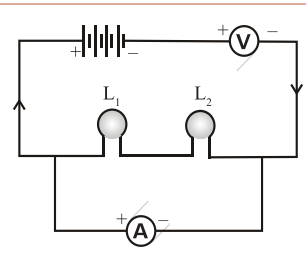
(i) Is there an error in this circuit? If so, point out the error and draw a diagram showing the correct way to connect this circuit. Use the appropriate circuit symbols in your diagram.
(ii) a. Are the two meters in series or parallel? b. Are the two lamps in series or parallel?
(iii) Is Current through two lamps L1 and L2 same?
Q-13
How does temperature affect the resistivity (specific resistance) in case of:
(i) Metals
(ii) Alloys
(iii) Semiconductors
(iv) Carbon
Multiple Choice Questions
Q-1 A fuse wire does not have:
(i)
A thin area of cross section
(ii)
High conductivity
(iii)
Low melting point
(iv)
Low resistivity
Q-2 A substance of zero resistance, at a very low temperature is:
(i)
Conductor of high resistance
(ii)
Superconductor
(iii)
Metal
(iv)
Insulator
Q-3 With the increase in temperature, the resistivity of semi conductor:
(i)
Increases
(ii)
Decreases
(iii)
No change
(iv)
None of these
Q-4 The slope of a I➔ V graph for a conductor represents:
(i)
Resistivity
(ii)
Conductivity
(iii)
Conductance
(iv)
Resistance
Q-5 Material used for standard resistance is:
(i)
Lead and tin alloy
(ii)
Tungsten
(iii)
Manganin
(iv)
Copper
Q-6 If a wire of resistance R is cut into five equal parts and connected in parallel, its equivalent resistance is:
(i)
R/25
(ii)
5/R
(iii)
25 R
(iv)
5R
Q-7 If a wire of resistance to 2 Ω is stretched to double its length, then its resistance will become:
(i)
0.5 Ω
(ii)
8 Ω
(iii)
1 Ω
(iv)
4 Ω
Q-8 lf a wire of length 'I' and having resistivity 'ρ' is cut into two equal parts, then resistivity of the two parts is:
(i)
2ρ
(ii)
ρ/2
(iii)
ρ
(iv)
4ρ
Q-9 From the I ➔ V graph, resistance obtained is:

(i)
3/5 Ω
(ii)
5/3 Ω
(iii)
6/12 Ω
(iv)
9/18 Ω
Q-10 A given length of a wire is tripled on itself. The ratio of the resistance of the wire before and after is:
(i)
3:1
(ii)
9:1
(iii)
1 :9
(iv)
1 :3
Q-11 Of the two wires XV having area A and X1Y1 having area A/2, what is the ratio of their resistance?
(i)
1:2
(ii)
2:1
(iii)
1:4
(iv)
1:1
Q-12 Assertion: When a battery is short circuited, the terminal voltage is zero. Reason: In short circuit, the current is zero.
(i)
Both assertion and reason are correct
(ii)
Assertion is false but reason is true
(iii)
Assertion is correct but reason is false
(iv)
Both assertion and reason are wrong
Q-13 Assertion: The statement of ohm's law is V = IR. Reason: V = IR is the equation which defines resistance.
(i)
Assertion is correct but reason is false
(ii)
Assertion is false but reason is true
(iii)
Both assertion and reason are wrong
(iv)
Both assertion and reason are correct
Chapter-9 Effect of Electric current and Household Circuits
Q-1
Answer the following Questions.
(i) What is meant by "heating effect of electric current"?
(ii) Explain what is meant by the term 'power'. Define its SI unit.
(iii) Distinguish between kilowatt and kilowatt hour.
(iv) What is the commercial unit of electric energy?
(v) How many joule of electric energy are contained in one kilowatt hour?
(vi) Derive the relation: P =V2/R
(vii) What is the SI unit of electric power?
(viii) Show that 1 kWh = 3.6 x 106 J.
(ix) When electric current is passed through a resistor, some heat is produced. Explain.
(x) State the factors that influence the heating effect of a current and give the relationship between them.
Q-2
Obtain an expression for the electric energy in terms of:
(i) Current and resistance
(ii) Current and potential difference
Q-3
Define:
(i) Watt
(ii) Kilowatt hour (kWh)
(iii) Watt hour
Q-4
Define the following terms:
(i) Voltage
(ii) Wattage
(iii) High tension wires
(iv) Board of Trade Unit (BTU)
Q-5
Answer these Questions.
(i) Explain the meaning of power-voltage rating of an appliance.
(ii) What is meant by a short circuit? Why does it occur?
(iii) What are the dangers associated with a short circuit?
(iv) What is a fuse? What is the function of a fuse in an electric circuit?
(v) Why is the fuse connected to the live wire?
(vi) Name the material of the fuse.
(vii) State two characteristics of fuse.
(viii) Explain the term 'Fuse Rating' .
(ix) What is the generating voltage at the electric power station?
(x) Why does the generating station transmit at high voltage?
(xi) What is the type of generating voltage? What is the frequency of the generating voltage?
(xii) Why is household wiring done in parallel? Give at least two reasons.
(xiii) What are the disadvantages of wiring a household circuit in series?
(xiv) State the advantages of ring system.
(xv) Draw a circuit diagram showing two electric bulbs, a three pin socket and a fan connected in a household circuit. Clearly show the position of switches and fuses.
(xvi) Explain with reason which material is use as:
(i) Connecting wires (ii) Fuse wire (iii) Heating element (iv) Filament
Q-6
Answer these Questions.
(a) What is meant by colour coding of wires?
(b) State the position of the following in an electric plug:
(i) Earth pin (ii) Live pin (iii) Neutral pin
(c) Why is the earthing terminal in a plug made thicker and longer as compared to live or neutral terminals?
(d) Draw a diagram of three pin plug.
(e) Draw three diagrams of dual or staircase switch.
Q-7
Answer the following Questions.
(i) Name the switch used in staircase wiring. Explain its working with proper diagram.
(ii) Why it is dangerous to touch a switch with wet hands?
(iii) Explain the term 'earthing' with reference to an electric appliance? Describe briefly why earthing is essential.
(iv) How does earthing protect the user from receiving electric shock?
(v) Which part of an electric appliance is earthed and why?
(vi) How is a household circuit earthed?
(vii) Two wires iron and copper of equal length and thickness are joined in parallel and the combination is put across a battery. The copper wire glows but not the iron wire. Why?
(viii) Write the expressions for electric power in terms of:
a. V and I b. V and R c. I and R
(ix) An electric bulb is rated 100 W - 250 V. What does this imply?
(x) An electric stove is rated 3 kW, 250 V. Explain whether or not this stove should be used in a circuit containing 13 A fuse.
(xi) (a) Two fuse wires are rated 15 A and 5 A. Which of the two will be thicker and why?
(b) In which type of circuit cables are used in the following?
a. A 1 5 A rating fuse. b. A 5 A rating fuse.
(xii) Why it is dangerous to replace fuse wire by a copper wire?
(xiii) The flexible lead used for connecting an electrical appliance to the mains, is made up of three separate wires coloured red, black and green.
Which one of these wires is meant for earthing?
(xiv) Name four devices which make use of only heating affect of current.
(xv) Name two devices which in addition to heat, produce light energy.
(xvi) Give three characteristics of a material used for making heating appliances.
(xvii) If you look at pin socket with earth socket at the top, then which of the lower socket is live- the one to the left or the one to the right of the socket?
(xviii) Which has a higher resistance, a 240 V, 40 W lamp or a 240 V 100 W lamp?
Q-8
Give reasons:
(i) The wires leading to an electric iron remain cold, while the element gets red hot.
(ii) Tungsten is used in an electric lamp.
(iii) Nichrome is used as a heating element.
(iv) Copper wires are used for wiring .
Q-9
A lady received a shock when she happened to touch an electric kettle even though the switch was off.
(i) State the possible reasons for the shock.
(ii) Point out the possible defect with the electric wiring inside the kitchen.
Multiple Choice Questions
Q-1 The material used to make a fuse is:
(i)
Aluminium
(ii)
Copper
(iii)
Alloy of lead and tin
(iv)
Alloy of nickel and chromium
Q-2 The MCB is connected in series to a:
(i)
Live wire
(ii)
Earth wire
(iii)
Neutral wire
(iv)
Both (a) and (c)
Q-3 A double pole switch disconnects:
(i)
Both (a) and (b)
(ii)
Live wire
(iii)
Neutral wire
(iv)
Earth wire
Q-4 Dual control switches are used in:
(i)
Staircases
(ii)
Refrigerators
(iii)
Long corridors
(iv)
Both (a) and (b)
Q-5 An electric appliance is connected between:
(i)
Live and neutral wire
(ii)
None of these
(iii)
Live and earth wire
(iv)
Neutral and earth wire
Q-6 The device used to protect an electric circuit from overloading and short circuits is:
(i)
Earthing
(ii)
Switch
(iii)
Fuse
(iv)
Both (a) and (c)
Q-7 Wires carrying current from a source to the distribution board are:
(i)
Live wires
(ii)
Neutral wires
(iii)
Earth wires
(iv)
Both (a) and (b)
Q-8 The part of an electrical appliance earthed is:
(i)
Heating element
(ii)
Metal body
(iii)
Coil of an electrical appliance
(iv)
All of these
Q-9 In an electric socket the hole on the right side is for the connection to the:
(i)
Neutral wire
(ii)
Both (a) and (b)
(iii)
Live wire
(iv)
Earth wire
Q-10 An electric motor of power 4000 Wis to be operated at from a power mains of 250 V. The current rating of the fuse should be:
(i)
20 A
(ii)
12 A
(iii)
10 A
(iv)
16 A
Q-11 The commercial unit of electrical energy is:
(i)
All of these
(ii)
Wh
(iii)
kWh
(iv)
W second
Chapter-10 Electromagnetism
Q-1
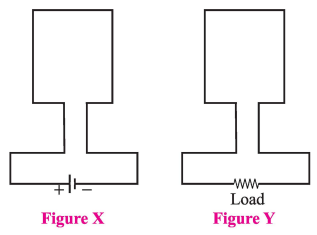
(a) Name the electric device shown in figure X and figure Y.
(b) State the energy transformation taking place in each.
(c) Give three differences between them .
Q-2
In an AC generator,
(i) What is the effect of increasing the speed of a rotation?
(ii) Suggest two alterations to produce a higher emf.
(iii) State the energy conversion that takes place.
Q-3
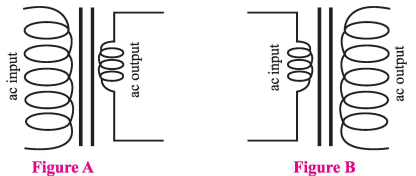
(a) Name the electric device shown in figure A and figure B
(b) Give three differences between them .
Q-4
When can an electric charge give rise to a magnetic field?
Q-5
Answer these Questions.
(a) From the figure given below, state the direction in which the magnetic needle will turn .
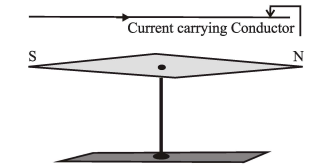
(b) State the law which helps to determine the direction of magnetic needle.
(c) If the strength of current is increased what changes will be observed?
(d) State the magnitude of the maximum angle through which the magnetic needle will turn .
(e) What would you observe: (i) If the current is reversed in the conductor? (ii) If the conductor is held below the magnetic needle?
Q-6
Copy the figure and draw the lines of magnetic field produced due to the current flowing

Q-7
Two conductors (straight wires) A and B, carrying equal currents in opposite directions, pass through a cardboard as shown in the figure.
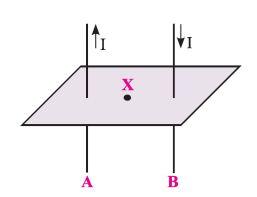
(a) Sketch separately the lines of force produced by each current,
(b) Show the direction of the magnetic field at the point X.
(c) What will be the effect on the magnetic field at X, if the current in B is reversed?
(d) Explain why the lines of force at a distance may differ in shape from those in the immediate vicinity of the conductors.
Q-8
How does the magnetic field set up by a solenoid change when:
(i) Number of turns are increased
(ii) Diameter of solenoid is increased
(iii) Strength of current in solenoid is decreased
(iv) A soft iron core is inserted within the solenoid
Q-9
The figure alongside shows the simple form of a DC motor.
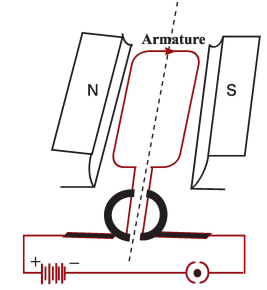
(a) State the observation in the armature after the switch is put on.
(b) What is the cause of the above observation?
(c) State the direction of rotation of coil (armature).
(d) How can you determine the direction of rotation?
(e) How can the speed or the power of the motor be increased?
Q-10
Name the device which converts electrical energy into mechanical energy
Q-11
a. Why does a current carrying wire move when placed in a magnetic field? b. What angle should the wire (conductor) make with the field so that the force acting on the wire is (i) maximum (ii) zero
Q-12
ABCD is a rectangular coil kept between the pole piece of a powerful magnet as shown below.

(i) Explain what happens when a current is passed through the coil in the direction of the arrows. Mark the direction of the forces on each arm.
(ii) What happens to the moment of the couple as the coil turns from the position indicated to that when its plane is perpendicular to the magnetic field? Why does the motion continue beyond this position?
Q-13
AB is a wire which hangs in a magnetic field and carries a current as shown in the figure. It is free to swing.
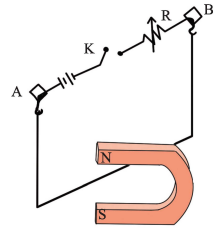
(i) Mark the direction of the current in AB.
(ii) Describe the motion of AB as long as key K is pressed.
(iii) What is the purpose of the variable resistor R?
Q-14
According to Faraday's coil and magnet experiment, state and explain what happens when the north pole of a magnet is moved
(i) towards the face of the coil connected to a galvanometer,
(ii) away from the face of the coil connected to a galvanometer. (Draw neat and correctly labelled sketches).
Q-15
The figure shows a fixed copper coil having many turns connected with a galvanometer. Observe the changes in the galvanometer when a bar magnet is brought near it and answer the following questions:
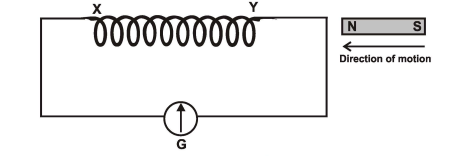
(i) The magnet is moved rapidly in the direction of arrow.
(ii) The magnet is stopped within the coil.
(iii) The magnet is rapidly moved away from the coil.
(iv) What polarity is induced at point Y when, a. The magnet is moved towards the coil? b. The magnet is moved away from the coil?
(v) Name the law applied to find the polarity at point Y.
(vi) Name the phenomenon that occurs.
Q-16
Answer the following Questions.
(i) What is meant by magnetic effect of electric current? Who discovered it?
(ii) Show with the help of neatly labelled sketches the magnetic fields produced when a current flows in each of the following: (i) A straight wire (ii) A circular loop (iii) A solenoid
(Show clearly the direction of the current and the lines of force in each case)
(iii) Describe an experiment to show that a current in a straight wire produces a magnetic effect. Write down the rule for deducing the direction of magnetic field around a straight wire.
(iv) Describe an experiment which shows that a current in a circular coil produces a magnetic effect. Write down a rule for deducing the direction of the magnetic field, and polarity produced.
(v) What is a solenoid? Describe an experiment to study the nature of the magnetic field produced by a solenoid when a current is passed through it. How will you find the polarity at the ends of a solenoid, without using a magnetic needle?
(vi) Draw a diagram of an electromagnet. Show clearly the current direction in the coil windings and the poles produced in the soft iron core. State three uses of an electromagnet.
(vii) State three factors on which the strength of a solenoid depends.
(viii) State two factors on which the strength of electromagnet depends.
(ix) Give four differences between electromagnets and permanent magnets.
(x) Set up a simple experiment to show that when a conductor carries a current in a magnetic field, then it experiences a force. State the magnitude and the direction of this force.
On what factors does this force depend? Name the law which determines the direction of force experienced by a conductor.
(xi) a. Give a sectional diagram of a DC motor, showing one armature coil and the direction of the magnetic field, the current, and the direction of the resulting motion.
b. Explain the action of the commutator with a sketch diagram.
(xii) What is the use of commutator in a DC motor?
(xiii) a. State the function of the following in a simple DC motor:(i) The soft iron cylinder (core) (iii) The carbon brushes (ii) The curved pole pieces of a field magnet (iv) Split rings
(xiv) State three ways in which the speed of the motor can be increased.
(xv) What are the disadvantages of a DC motor?
(xvi) Write the expression for the force acting on a current carrying conductor when placed in a magnetic field.
(xvii) What is the SI unit of magnetic field?
(xviii) State Faraday's Laws of Electromagnetic Induction.
(xix) Give a sectional diagram of an AC dynamo, showing one armature coil and the direction of the field, the motion and the current induced in the coil.
(xx) With the help of a graph explain the nature of the induced emf.
(xxi) On what factors does the emf generated by a dynamo depend? If the speed of rotation is decreased, what is the effect on the magnitude of the induced emf?
Q-17
Indicate the following in the diagrams A and B given alongside:
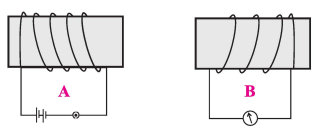
(i) The direction of electron flow in A.
(ii) The polarity of the right face of the solenoid A.
(iii) The direction of the induced current in solenoid B.
Q-18
Long Type of Questions.
(i) What is the principle of a transformer?
(ii) What is a transformer? State its use.
(iii) Why is the core of a transformer laminated?
(iv) What is meant by step up and step down transformer? State their uses.
(v) Give a sectional diagram of a step down and step up transformer. Label their essential features.
(vi) State the factors on which the amplitude of emf induced in the secondary coil of transformer depends.
(vii) Define transformation ratio.
(viii) What are the energy losses in an actual transformer?
Q-19
Name a device which converts mechanical energy into electrical energy. State its working principle.
Q-20
An electric generator has two slip rings.
(i) What kind of current does it produce?
(ii) What is the use of the two slip rings?
(iii) What is the difference between the rings of a DC motor and those of an AC generator?
Multiple Choice Questions
Q-1 The most suitable material for making the core of an electromagnet is:
(i)
Steel
(ii)
Aluminium
(iii)
Soft iron
(iv)
Silver
Q-2 When a straight conductor is carrying current:
(i)
There are magnetic field lines parallel to the conductor
(ii)
There are no magnetic field lines
(iii)
There are magnetic field lines which cut the conductor
(iv)
There are circular magnetic field lines around it
Q-3 A circular loop carries current as shown. Choose the correct answer:

(i)
Face A of the loop (facing towards you) acts as a the South Pole and face B acts as a the North Pole
(ii)
Face B of the loop acts as the South Pole and face A acts as the North Pole
(iii)
Both the faces cannot act as a North Pole or South Pole
(iv)
None of the above
Q-4 The magnitude of magnetic field at a point due to a current carrying conductor depends:
(i)
Only on the magnitude of current
(ii)
Only a small part of length of the conductor
(iii)
On the length of the wire and on the magnitude of current
(iv)
Both (a) and (b)
Q-5 The front face of a circular wire carrying current behaves like a South Pole, the direction of current in this face of the circular wire is:
(i)
Clockwise
(ii)
Anticlockwise
(iii)
Downward
(iv)
Upward
Q-6 An electric motor is a device which converts:
(i)
Electrical energy to mechanical energy
(ii)
Chemical to mechanical energy
(iii)
Mechanical to light energy
(iv)
Mechanical energy to electrical energy
Q-7 The phenomenon of electromagnetic induction is:
(i)
The process of producing induced current in a coil
(ii)
The process of rotating a coil
(iii)
The process of charging a body
(iv)
The process of generating magnetic field due to a current carrying coil
Q-8 The direction of induced current is given by:
(i)
Flemings left hand rule
(ii)
Right hand thumb rule
(iii)
Clock rule
(iv)
Flemings right hand rule
Q-9 AC generator converts:
(i)
Electric energy to mechanical energy
(ii)
Light energy to electric energy
(iii)
Electric energy to magnetic energy
(iv)
Mechanical energy to electric energy
Q-10 The difference between direct current and alternating current is:
(i)
They both are changing the direction of current
(ii)
They both are constant in magnitude
(iii)
Direct current is variable but alternating current is constant with time
(iv)
Alternating current is variable but direct current is constant with time
Q-11 Whenever the magnetic field linked with the coil changes, an EMF is induced in the circuit and EMF lasts:
(i)
Forever
(ii)
So long as the change in field takes place
(iii)
For a short time
(iv)
For a long time
Q-12 A magnet NS is placed along the axis of a circular coil. The magnet is moved away from the coil. The induced current in the coil is:

(i)
Zero
(ii)
Clockwise
(iii)
Anticlockwise
(iv)
None of these
Q-13 Four situations are as follows:
1. An infinitely long wire carrying current
2. A rectangular loop carrying current
3. A solenoid of finite length carrying current
4. A circular loop carrying current
In which of the above cases will the magnetic field produced be like that of a bar magnet?
1. An infinitely long wire carrying current
2. A rectangular loop carrying current
3. A solenoid of finite length carrying current
4. A circular loop carrying current
(i)
1 and 3
(ii)
Only 3
(iii)
Only 4
(iv)
1
Q-14 The transformer core is laminated in order to:
(i)
Simplify its construction
(ii)
Minimize eddy current loss
(iii)
Reduce cost
(iv)
both (a) and (b)
Q-15 The diagram is a simple sketch of a transformer. The correct sentence or sentences is:
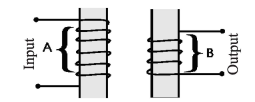
(i)
All of the above are correct
(ii)
A is a primary coil and B is a secondary coil
(iii)
It is a sketch of a step-up transformer
(iv)
Turn ratio NS/NP is more than 1
Chapter-11 Calorimetry and Latent Heat
Q-1
Define the following terms and write the SI unit of each:
(i) Heat capacity
(ii) Specific heat capacity
Q-2
Answer the Following Question.
(i) How does the heat capacity of a substance differ from its specific heat capacity?
(ii) What is the relation between: (i) Joule and calorie? (ii) Joule and kilocalorie?
(iii) State the principle of calorimetry.
(iv) Explain how the law of conservation is contained in the principle of calorimetry.
(v) James Joule demonstrated that almost all of mechanical energy would be converted into heat energy. Is it possible to convert all heat energy into mechanical energy? Support your answer with a suitable example.
(vi) A hot stone is placed in a pail of cold water. Is work done by the stone on the water?
(vii) If the pail in the above example is thermally insulated, what happens to the total internal energy of the stone and water while (i) the stone cools down (ii) the water warms up?
(viii) If equal amounts of heat is supplied to equal quantities of oil and water, which substance will record a higher rise in temperature? Explain.
(ix) Define the term latent heat of fusion of ice. State its SI unit.
(x) Give a brief account of how latent heat influences the weather.
(xi) Why does the temperature of body remain steady when the body is undergoing a change in state?
(xii) Would you select a liquid having a high specific heat capacity as a thermometric liquid? Explain your answer.
(xiii) Draw a graph to show temperature change during the time when ice at - 10°C is heated and changed into water at 100°C.
Q-3
State the relation between specific heat capacity and amount of heat with:
(i) Temperature (Rise or fall in)
(ii) Mass of substance
Q-4
Define:
(i) Calorie
(ii) kilocalorie
(iii) Joule
Q-5
Explain how this property of water is useful:
(i) To farmers
(ii) In moderating climate
(iii) In car radiators
(iv) To aquatic plants and animals
Q-6
In an experiment to determine: What are the common precautions required?
(a) The specific heat capacity of a solid.
(b) The specific latent heat of fusion of ice
Q-7
Give Reasons:
(i) It is generally cold after a hailstorm than during and before the hailstorm.
(ii) Snow on mountain does not melt all at once.
(iii) Weather gets pleasant when freezing starts in cold countries.
(iv) Ice at 0°C feels colder than water at 0°C.
Q-8
State whether heat is being evolved or absorbed by the body in each of the following examples:
(i) Melting of snow
(ii) Condensation of steam
(iii) Formation of ice
(iv) Sublimation of iodine
(v) Evaporation of alcohol
(vi) Liquefaction of solid
Q-9
State the effect of increase of pressure on:
(i) a. Melting point of ice. b. Boiling point of water.
(ii) State the effect of presence of impurities on: a. Melting point of ice b. Boiling point of water.
(iii) a. It is difficult to cook vegetables on hills. Why? b. Salt is sprinkled on icy roads in cold countries during winter. Why?
Multiple Choice Questions
Q-1 The specific latent heat of ice is:
(i)
2260 J g- 1
(ii)
336 J kg- 1
(iii)
80 cal g- 1
(iv)
80J g- 1
Q-2 The amount of heat energy contained in a body depends upon:
(i)
Mass
(ii)
Temperature
(iii)
Nature of the body
(iv)
All of these
Q-3 The relation between the Kelvin (TK) scale and degree Celsius (°C) is:
(i)
t K + t°C = 273
(ii)
TK + 273 = t°C
(iii)
t°C=TK - 273
(iv)
TK + t°C = -273
Q-4 The difference in temperature is equal to 25 K. Choose the correct sentence.
(i)
Therefore difference in temperature is equal to 25 ° F
(ii)
Therefore difference in temperatures equal to 298°C
(iii)
Therefore difference in temperatures equal to 25° C
(iv)
None of the above
Q-5 The relation between heat capacity (C') and specific heat capacity (C) of a body of mass (m) is:
(i)
C' = C/m
(ii)
C = m x C'
(iii)
C' = m x C
(iv)
C/C' = 1
Q-6 Heat capacity per unit mass is called:
(i)
Latent heat
(ii)
Specific heat capacity
(iii)
Heat energy
(iv)
Calorie
Q-7 The sum of potential energy and kinetic energy in a body is called:
(i)
Latent heat
(ii)
Thermal energy
(iii)
Internal energy
(iv)
Heat energy
Q-8 1000 J of heat energy is needed to heat 1 kg of paraffin through 1°C. Therefore heat energy required to heat 5 kg of paraffin through 2°C is:
(i)
10,000 J
(ii)
25,000 J
(iii)
20,000 J
(iv)
1,000 J
Q-9 To convert 4 kg of ice at 0°C into water at 0°C, the amount of heat required is:
(i)
336 kJ
(ii)
1334 kJ
(iii)
1344 J
(iv)
336 J
Q-10 Specific heat capacity of substance A is 3.8 J g-1 K- 1 and of substance B is 0.4 J g- 1 K- 1 • Hence:
(i)
B is a good conductor of heat
(ii)
A is useful in car radiator
(iii)
A shows a greater rise in temperature than B when both are supplied the same amount of heat energy
(iv)
Both (a) and (b)
Q-11 Heat supplied to a solid, changes it into to liquid. The energy absorbed during the phase change is called:
(i)
Specific heat capacity
(ii)
Heat capacity
(iii)
Latent heat of vapourisation
(iv)
Latent heat of melting/ fusion
Q-12 A certain amount of heat 'Q' will warm 1g of material A by 5°C and 1 g of material B by 3°C. Hence:
(i)
B is a good conductor of heat
(ii)
A is useful in car radiator
(iii)
Both (a) and (b)
(iv)
A shows a greater rise in temperature than B when both are supplied the same amount of heat energy. Hence A has lower specific heat capacity
Q-13 By increasing the pressure on ice:
(i)
Melting point of ice decreases
(ii)
Ice will not melt faster
(iii)
Used to make freezing mixture with salt
(iv)
All the above
Q-14 The graph shows the heating of naphthalene. Select the correct option from the following:

(i)
All points are correct.
(ii)
Points 1 and 4 are correct but points 2 and 3 are wrong.
(iii)
Points 1 and 2 are correct but points 3 and 4 are wrong.
(iv)
Points 1 and 3 are correct but points 2 and 4 are wrong.
Chapter-12 Radioactivity
Q-1
Answer the following Questions.
(i) Define an atom, and state its composition.
(ii) Compare an electron, a proton and a neutron in terms of their masses and charges.
(iii) An atom is electrically neutral. Explain.
(iv) List three differences between chemical reactions and nuclear reactions.
(v) Explain the meaning of the terms: (a) Atomic number (b) Mass number
Q-2
Answer these Questions.
(a) Why are the heavy atoms radioactive?
(b) Why is radioactivity a nuclear phenomenon?
(c) How are the protons and neutrons bound together in a nucleus?
(d) What is the speed of alpha-particles, beta-particles and gamma-rays when emitted from the nucleus?
(e) All three radiations are dangerous. Why?
(f) Why are y-rays (gamma) the most dangerous than α-rays and β-rays?
Q-3
Answer these Questions.
(a) Give a concise account of the phenomenon known as radioactivity.
(b) Explain how Rutherford analysed the radiation into three main types.
(c) Give a list of the essential properties of the three types of radiation involved in radioactive decay.
(d) Explain, how these radiations are used in modern life?
(e) State three safety precautions that must be taken while handling radioactive substances.
Q-4
Answer the Following Questions.
(i) What are radioactive substances? Name two radioactive elements.
(ii) What are background radiations? Give three sources of background radiations.
(iii) Compare the ionising and penetrating powers of α, β and γ rays.
(iv) State three isotopes of C-14.
(v) Write down the nuclear reaction for C-14 decay.
(vi) Write down one use of C-14 isotope.
Q-5
The atom of an element X has 9 protons, 9 electrons and 10 neutrons.
(i) What is the atomic number of the element?
(ii) What is the mass number of the element?
(iii) Another particle has 9 protons, 9 electrons and 11 neutrons. Give a name that describes it.
(iv) What is element X called if its composition becomes: 9 protons, 10 electrons and 10 neutrons?
Q-6
Answer these Questions.
(a) Write down the composition of alpha, beta and gamma rays. Out of these rays: i. Which has the least penetrating power? ii. Which has the maximum ionisation power? Which travels with the same speed of light? iii. Which are charged particles? Mention the charge on each.
(b) What type of energy changes take place during the decay of radioactive nuclei?
Q-7
Answer the Following Questions.
(i) How do the α-particles, β-particles and γ-rays behave in a magnetic field?
(ii) As shown in the diagram alongside, an electric field is applied (P and Q plates) to the path of nuclear radiations emitted by radioactive substance. (i) Identify A, B and C (ii) What polarity is on the two plates P and Q? (iii) Mention the charges on A,B and C. (iv) Name the phenomenon taking place.
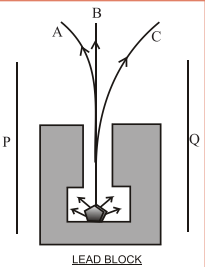
(iii) What is (i) alpha decay (ii) beta decay and (iii) gamma decay? Give one example of each decay.
(iv) What happens to atomic number and atomic mass number of an element in each above mentioned decay?
(v) Which emission does not change the place of an element in the periodic table?
(vi) An isotope of uranium changes into thorium by the emission of one alpha particle. Write down an equation for the nuclear disintegration taking place. [For uranium, atomic mass number = 238 and atomic number = 92]
(vii) The element sodium changes to magnesium by the emission of one beta particle. Write down an equation for the nuclear disintegration taking place. [For sodium atomic mass number = 24 and atomic number = 11]
(viii) Aluminium emits a y-ray. What is the resulting nucleus?
(ix) A radioactive substance is oxidised. What change would you expect to take place in the nature of its radioactivity? Give reason for your answer.
(x) Name the gas formed when an a-particle acquires two electrons.
(xi) An α-particle absorbs an electron. What does it change to?
(xii) A mass of lead is embedded in a block of aluminium (2 mm thick). Radiation from a radioactive source incident on the side of a block produces a shadow on a fluorescent screen placed beyond the block. The shadow of the block of aluminium is fainter than the shadow of lead. Explain.
(xiii) Name the technique used to estimate the age of very old trees, plants, wood and other surface specimens. Name the isotope that is formed and explain the basis of this technique.
Q-8
Give reasons:
(a) Alpha particles have maximum ionising power.
(b) Alpha particles and infra rays are different.
(c) Gamma rays and X-rays are different though they both are electromagnetic waves.
(d) Beta particles and cathode rays are different.
Q-9
Name the type of nuclear energy fission or fusion that is true for the statements given.
(i) This releases more energy per unit mass of substance.
(ii) It is possible at ordinary temperatures.
(iii) It is the source of energy for the Sun and other stars.
(iv) The substance used for this process is radioactive.
Q-10
Fill in the blanks:
(i) _______ isotope of uranium is more fissionable.
(ii) The approximate value of energy released in the fission of one U-235 nucleus is ______ MeV.
(iii) The temperature required for nuclear fusion is ______ K.
(iv) The energy with which nucleons are bounded within the nucleus is ________.
(v) Einsten's equation related to mass and energy is _________
Q-11
Answer these Questions.
(i) What is nuclear fission?
(ii) Name the substance used in nuclear fission.
(iii) Write one fission reaction.
(iv) What is atomic mass unit (amu)?
(v) 1 amu = ________ MeV
(vi) Explain what is meant by nuclear energy.
(vii) What is nuclear fusion? Write one nuclear fusion reaction.
(viii) Give another term used to describe nuclear fusion. Explain why this term is used.
Multiple Choice Questions
Q-1 An alpha particle consists of:
(i)
Three protons and one neutron
(ii)
Two protons and two electrons
(iii)
Two protons and two neutrons
(iv)
Four neutrons
Q-2 1 amu of mass is equal to:
(i)
932 MeV
(ii)
931 MeV
(iii)
930 MeV
(iv)
950 MeV
Q-3 The sum of the protons and neutrons present in an atom of an element is called:
(i)
Mass number
(ii)
Nucleon
(iii)
Both (a) and (b)
(iv)
Atomic number
Q-4 Atoms with the same number of neutrons but different number of protons are called:
(i)
Isotopes
(ii)
lsotones
(iii)
Isobars
(iv)
Atoms
Q-5 The ionizing power of alpha radiation is:
(i)
High
(ii)
Low
(iii)
More than beta but less than gamma
(iv)
Less than beta but more than gamma
Q-6 In the emission of gamma radiations, there is a:
(i)
Change in number of protons
(ii)
Change in number of neutrons
(iii)
No change in number of protons and neutron
(iv)
Both (a) and (b)
Q-7 Which is correct about beta particles?
(i)
During beta emission, the number of protons increased by one
(ii)
They are negatively charged particles
(iii)
Parent and daughter nuclei after one beta emission are Isobars
(iv)
All are correct
Q-8 A certain nucleus has a mass number 24 and atomic number 11. The number of neutrons is:
(i)
14
(ii)
13
(iii)
35
(iv)
11
Q-9 The element used to cure cancer and to detect brain tumor is:
(i)
Sodium-24
(ii)
lron-59
(iii)
Cobalt-60
(iv)
Carbon-14
Q-10 In carbon-14 dating process, the particles of radiation are emitted as:
(i)
Alpha particle
(ii)
Gamma particle
(iii)
Beta particle
(iv)
None of these
Q-11 The process in which a heavy nucleus divides into two lighter nuclei is a:
(i)
Radioactivity
(ii)
Nuclear fission
(iii)
Nuclear fusion
(iv)
Both (a) and (b)
Q-12 The process in which two lighter nuclei combine together to form a heavy nucleus is:
(i)
Nuclear fission
(ii)
Chain reaction
(iii)
All of these
(iv)
Nuclear fusion
Q-13 Which of the following isotopes of Uranium is more fissionable?
(i)
U - 234
(ii)
U - 238
(iii)
U - 235
(iv)
U - 236